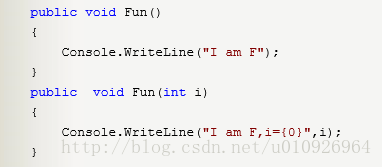C#方法重载(overload)、重写(覆盖)(override)、隐藏(new)
重载
同一个作用域内发生(比如一个类里面),定义一系列同名方法,但是方法的参数列表不同。这样才能通过传递不同的参数来决定到底调用哪一个。而返回值类型不同是不能构成重载的。
作用: 重载必须发生在一个类中,函数名相同,参数类型或者个数可以不同,返回值类型可以不同。根据参数选择调用方法。重载就是让类以统一的方式处理不同的数据,在同一个类中多个方法可以用同一个名字就叫做方法重载。

重写override
作用:用于实现接口、抽象类、虚方法
重写override一般用于接口实现和继承类的方法改写,要注意:
1、覆盖的方法的标志必须要和被覆盖的方法的标志完全匹配,才能达到覆盖的效果;
2、从 C# 9.0 开始,override 方法支持协变返回类型。 具体而言,override 方法的返回类型可从相应基方法的返回类型派生。 在 C# 8.0 和更早版本中,override 方法和重写基方法的返回类型必须相同。
3、不能重写非虚方法或静态方法。 重写基方法必须是 virtual、abstract 或 override。
4、覆盖的方法所抛出的异常必须和被覆盖方法的所抛出的异常一致,或者是其子类;
5、被覆盖的方法不能为private,否则在其子类中只是新定义了一个方法,并没有对其进行覆盖。
重写object 类型的ToString()
6、可以说,override是一个非常智能的东西,它可以动态决定究竟是采用父类还是子类的方法。
public override string ToString()
{
return base.ToString();
}
隐藏(new)
隐藏简单地说就是基类中已经定义的方法,派生类中也需要用,而两个方法完全相同的话就会出现语法错误,所以用关键字new把基类中的方法隐藏了,但是该方法想用的时候还可以发挥作用,又不会发生语法冲突。
using System; using System.Text; namespace OverrideAndNew { class Program { static void Main(string[] args) { BaseClass bc = new BaseClass(); DerivedClass dc = new DerivedClass(); BaseClass bcdc = new DerivedClass(); // The following two calls do what you would expect. They call // the methods that are defined in BaseClass. bc.Method1(); bc.Method2(); // Output: // Base - Method1 // Base - Method2 // The following two calls do what you would expect. They call // the methods that are defined in DerivedClass. dc.Method1(); dc.Method2(); // Output: // Derived - Method1 // Derived - Method2 // The following two calls produce different results, depending // on whether override (Method1) or new (Method2) is used. bcdc.Method1(); bcdc.Method2(); // Output: // Derived - Method1 // Base - Method2 } } class BaseClass { public virtual void Method1() { Console.WriteLine("Base - Method1"); } public virtual void Method2() { Console.WriteLine("Base - Method2"); } } class DerivedClass : BaseClass { public override void Method1() { Console.WriteLine("Derived - Method1"); } public new void Method2() { Console.WriteLine("Derived - Method2"); } } }
编程是个人爱好






【推荐】国内首个AI IDE,深度理解中文开发场景,立即下载体验Trae
【推荐】编程新体验,更懂你的AI,立即体验豆包MarsCode编程助手
【推荐】抖音旗下AI助手豆包,你的智能百科全书,全免费不限次数
【推荐】轻量又高性能的 SSH 工具 IShell:AI 加持,快人一步
· TypeScript + Deepseek 打造卜卦网站:技术与玄学的结合
· Manus的开源复刻OpenManus初探
· 写一个简单的SQL生成工具
· AI 智能体引爆开源社区「GitHub 热点速览」
· C#/.NET/.NET Core技术前沿周刊 | 第 29 期(2025年3.1-3.9)